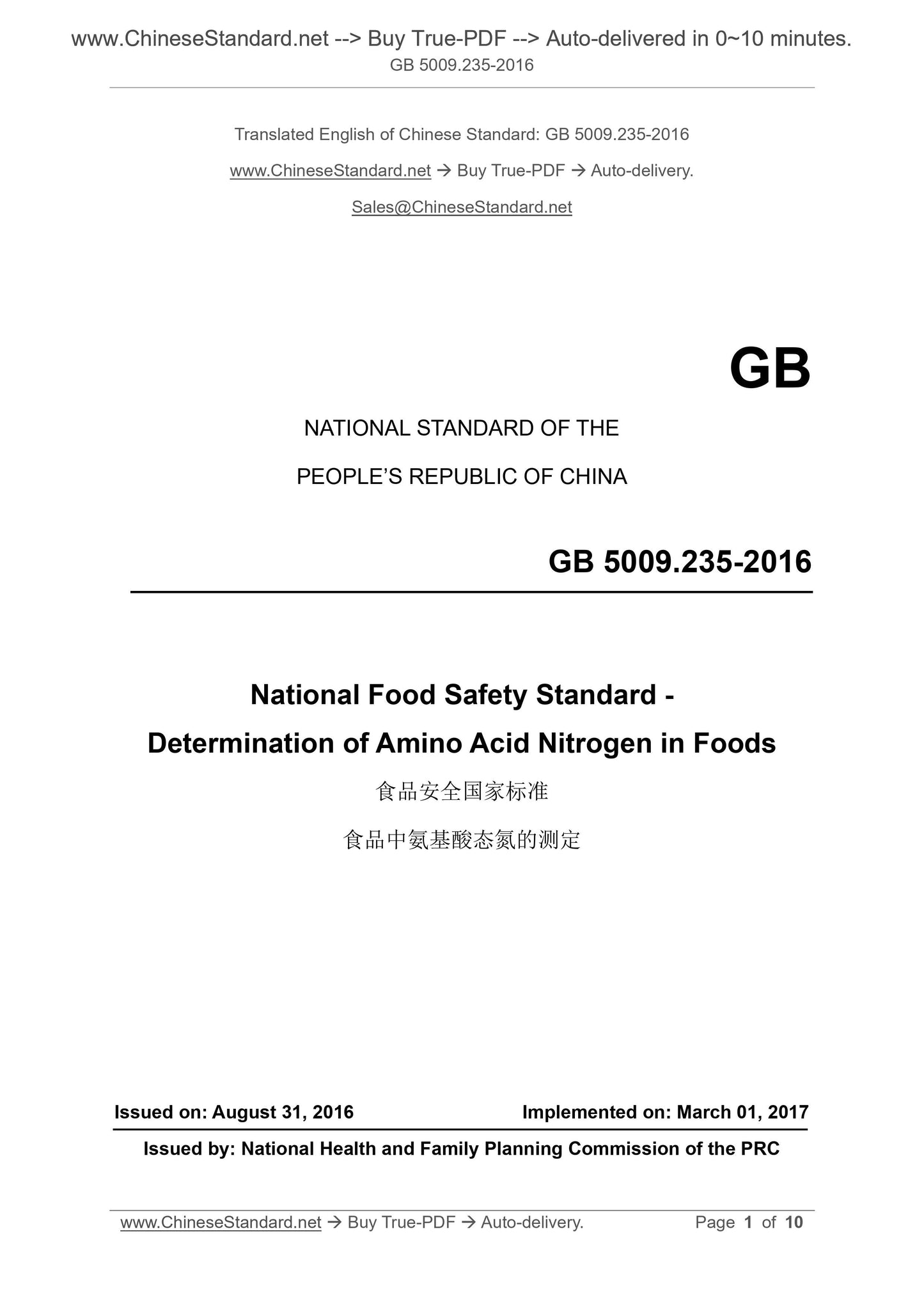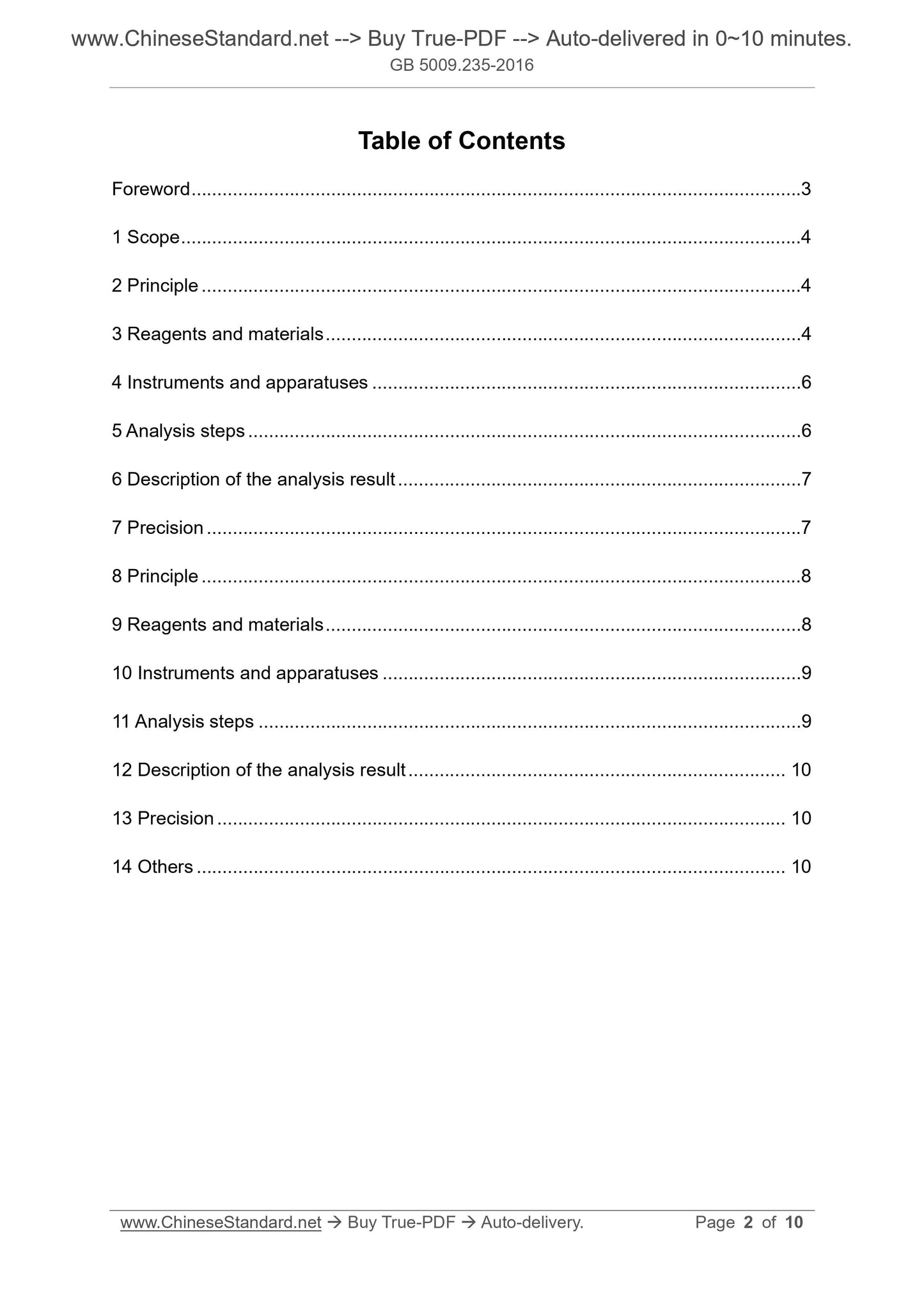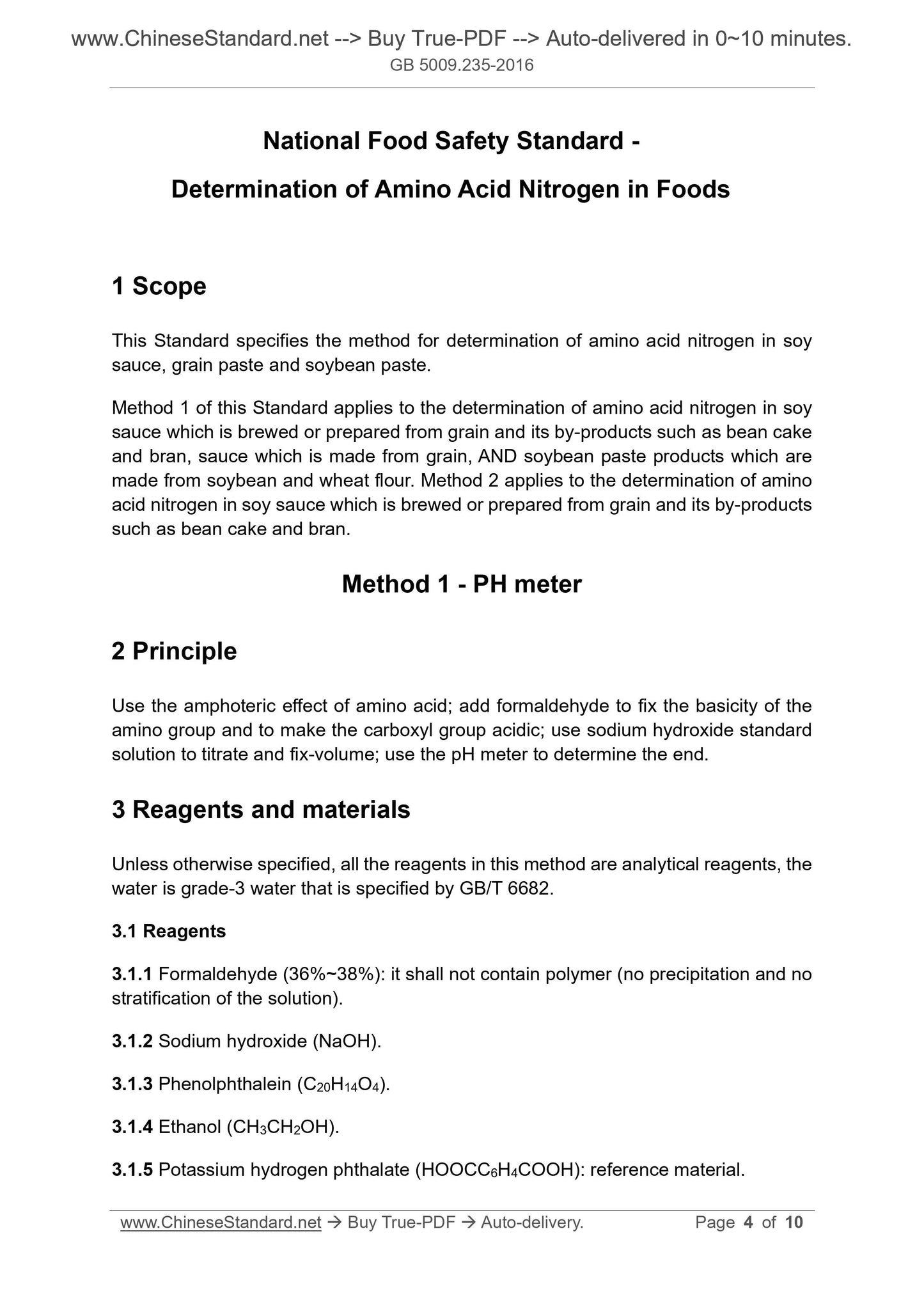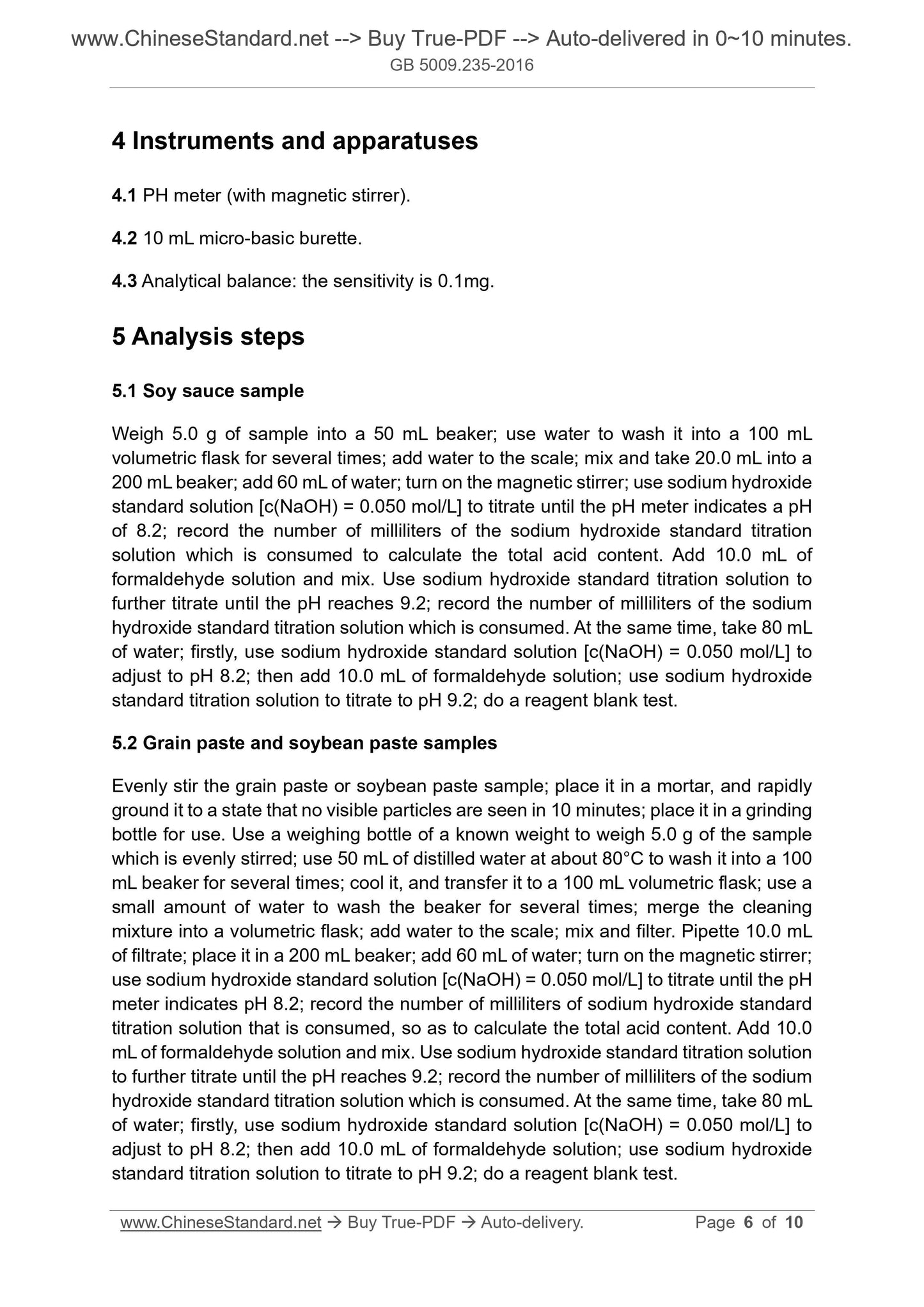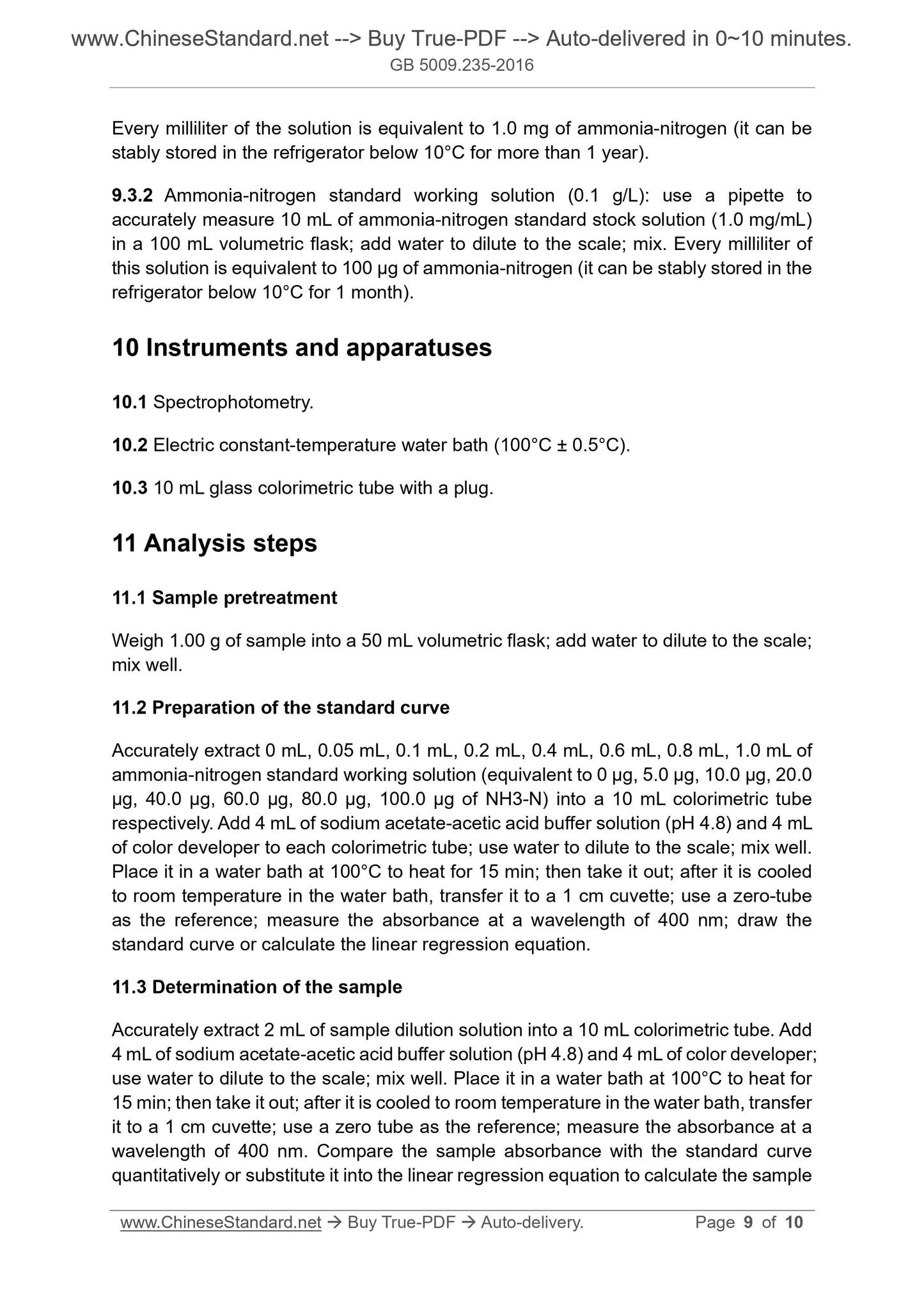1
/
of
5
www.ChineseStandard.us -- Field Test Asia Pte. Ltd.
GB 5009.235-2016 English PDF
GB 5009.235-2016 English PDF
Regular price
$90.00
Regular price
Sale price
$90.00
Unit price
/
per
Shipping calculated at checkout.
Couldn't load pickup availability
GB 5009.235-2016: National food safety standard - Determination of Amino Acid Nitrogen in Foods
Delivery: 9 seconds. Download (& Email) true-PDF + Invoice.
Get Quotation: Click GB 5009.235-2016 (Self-service in 1-minute)
Historical versions (Master-website): GB 5009.235-2016
Preview True-PDF (Reload/Scroll-down if blank)
GB 5009.235-2016
GB
NATIONAL STANDARD OF THE
PEOPLE’S REPUBLIC OF CHINA
National Food Safety Standard -
Determination of Amino Acid Nitrogen in Foods
ISSUED ON: AUGUST 31, 2016
IMPLEMENTED ON: MARCH 01, 2017
Issued by: National Health and Family Planning Commission of the PRC
Table of Contents
Foreword ...3
1 Scope ...4
2 Principle ...4
3 Reagents and materials ...4
4 Instruments and apparatuses ...6
5 Analysis steps ...6
6 Description of the analysis result ...7
7 Precision ...7
8 Principle ...8
9 Reagents and materials ...8
10 Instruments and apparatuses ...9
11 Analysis steps ...9
12 Description of the analysis result ... 10
13 Precision ... 10
14 Others ... 10
National Food Safety Standard -
Determination of Amino Acid Nitrogen in Foods
1 Scope
This Standard specifies the method for determination of amino acid nitrogen in soy
sauce, grain paste and soybean paste.
Method 1 of this Standard applies to the determination of amino acid nitrogen in soy
sauce which is brewed or prepared from grain and its by-products such as bean cake
and bran, sauce which is made from grain, AND soybean paste products which are
made from soybean and wheat flour. Method 2 applies to the determination of amino
acid nitrogen in soy sauce which is brewed or prepared from grain and its by-products
such as bean cake and bran.
Method 1 - PH meter
2 Principle
Use the amphoteric effect of amino acid; add formaldehyde to fix the basicity of the
amino group and to make the carboxyl group acidic; use sodium hydroxide standard
solution to titrate and fix-volume; use the pH meter to determine the end.
3 Reagents and materials
Unless otherwise specified, all the reagents in this method are analytical reagents, the
water is grade-3 water that is specified by GB/T 6682.
3.1 Reagents
3.1.1 Formaldehyde (36%~38%): it shall not contain polymer (no precipitation and no
stratification of the solution).
3.1.2 Sodium hydroxide (NaOH).
3.1.3 Phenolphthalein (C20H14O4).
3.1.4 Ethanol (CH3CH2OH).
3.1.5 Potassium hydrogen phthalate (HOOCC6H4COOH): reference material.
4 Instruments and apparatuses
4.1 PH meter (with magnetic stirrer).
4.2 10 mL micro-basic burette.
4.3 Analytical balance: the sensitivity is 0.1mg.
5 Analysis steps
5.1 Soy sauce sample
Weigh 5.0 g of sample into a 50 mL beaker; use water to wash it into a 100 mL
volumetric flask for several times; add water to the scale; mix and take 20.0 mL into a
200 mL beaker; add 60 mL of water; turn on the magnetic stirrer; use sodium hydroxide
standard solution [c(NaOH) = 0.050 mol/L] to titrate until the pH meter indicates a pH
of 8.2; record the number of milliliters of the sodium hydroxide standard titration
solution which is consumed to calculate the total acid content. Add 10.0 mL of
formaldehyde solution and mix. Use sodium hydroxide standard titration solution to
further titrate until the pH reaches 9.2; record the number of milliliters of the sodium
hydroxide standard titration solution which is consumed. At the same time, take 80 mL
of water; firstly, use sodium hydroxide standard solution [c(NaOH) = 0.050 mol/L] to
adjust to pH 8.2; then add 10.0 mL of formaldehyde solution; use sodium hydroxide
standard titration solution to titrate to pH 9.2; do a reagent blank test.
5.2 Grain paste and soybean paste samples
Evenly stir the grain paste or soybean paste sample; place it in a mortar, and rapidly
ground it to a state that no visible particles are seen in 10 minutes; place it in a grinding
bottle for use. Use a weighing bottle of a known weight to weigh 5.0 g of the sample
which is evenly stirred; use 50 mL of distilled water at about 80°C to wash it into a 100
mL beaker for several times; cool it, and transfer it to a 100 mL volumetric flask; use a
small amount of water to wash the beaker for several times; merge the cleaning
mixture into a volumetric flask; add water to the scale; mix and filter. Pipette 10.0 mL
of filtrate; place it in a 200 mL beaker; add 60 mL of water; turn on the magnetic stirrer;
use sodium hydroxide standard solution [c(NaOH) = 0.050 mol/L] to titrate until the pH
meter indicates pH 8.2; record the number of milliliters of sodium hydroxide standard
titration solution that is consumed, so as to calculate the total acid content. Add 10.0
mL of formaldehyde solution and mix. Use sodium hydroxide standard titration solution
to further titrate until the pH reaches 9.2; record the number of milliliters of the sodium
hydroxide standard titration solution which is consumed. At the same time, take 80 mL
of water; firstly, use sodium hydroxide standard solution [c(NaOH) = 0.050 mol/L] to
adjust to pH 8.2; then add 10.0 mL of formaldehyde solution; use sodium hydroxide
standard titration solution to titrate to pH 9.2; do a reagent blank test.
Every milliliter of the solution is equivalent to 1.0 mg of ammonia-nitrogen (it can be
stably stored in the refrigerator below 10°C for more than 1 year).
9.3.2 Ammonia-nitrogen standard working solution (0.1 g/L): use a pipette to
accurately measure 10 mL of ammonia-nitrogen standard stock solution (1.0 mg/mL)
in a 100 mL volumetric flask; add water to dilute to the scale; mix. Every milliliter of
this solution is equivalent to 100 μg of ammonia-nitrogen (it can be stably stored in the
refrigerator below 10°C for 1 month).
10 Instruments and apparatuses
10.1 Spectrophotometry.
10.2 Electric constant-temperature water bath (100°C ± 0.5°C).
10.3 10 mL glass colorimetric tube with a plug.
11 Analysis steps
11.1 Sample pretreatment
Weigh 1.00 g of sample into a 50 mL volumetric flask; add water to dilute to the scale;
mix well.
11.2 Preparation of the standard curve
Accurately extract 0 mL, 0.05 mL, 0.1 mL, 0.2 mL, 0.4 mL, 0.6 mL, 0.8 mL, 1.0 mL of
ammonia-nitrogen standard working solution (equivalent to 0 μg, 5.0 μg, 10.0 μg, 20.0
μg, 40.0 μg, 60.0 μg, 80.0 μg, 100.0 μg of NH3-N) into a 10 mL colorimetric tube
respectively. Add 4 mL of sodium acetate-acetic acid buffer solution (pH 4.8) and 4 mL
of color developer to each colorimetric tube; use water to dilute to the scale; mix well.
Place it in a water bath at 100°C to heat for 15 min; then take it out; after it is cooled
to room temperature in the water bath, transfer it to a 1 cm cuvette; use a zero-tube
as the reference; measure the absorbance at a wavelength of 400 nm; draw the
standard curve or calculate the linear regression equation.
11.3 Determination of the sample
Accurately extract 2 mL of sample dilution solution into a 10 mL colorimetric tube. Add
4 mL of sodium acetate-acetic acid buffer solution (pH 4.8) and 4 mL of color developer;
use water to dilute to the scale; mix well. Place it in a water bath at 100°C to heat for
15 min; then take it out; after it is cooled to room temperature in the water bath, transfer
it to a 1 cm cuvette; use a zero tube as the reference; measure the absorbance at a
wavelength of 400 nm. Compare the sample absorbance with the standard curve
quantitatively or substitute it into the linear regression equation to calculate the sample
GB 5009.235-2016
GB
NATIONAL STANDARD OF THE
PEOPLE’S REPUBLIC OF CHINA
National Food Safety Standard -
Determination of Amino Acid Nitrogen in Foods
ISSUED ON: AUGUST 31, 2016
IMPLEMENTED ON: MARCH 01, 2017
Issued by: National Health and Family Planning Commission of the PRC
Table of Contents
Foreword ...3
1 Scope ...4
2 Principle ...4
3 Reagents and materials ...4
4 Instruments and apparatuses ...6
5 Analysis steps ...6
6 Description of the analysis result ...7
7 Precision ...7
8 Principle ...8
9 Reagents and materials ...8
10 Instruments and apparatuses ...9
11 Analysis steps ...9
12 Description of the analysis result ... 10
13 Precision ... 10
14 Others ... 10
National Food Safety Standard -
Determination of Amino Acid Nitrogen in Foods
1 Scope
This Standard specifies the method for determination of amino acid nitrogen in soy
sauce, grain paste and soybean paste.
Method 1 of this Standard applies to the determination of amino acid nitrogen in soy
sauce which is brewed or prepared from grain and its by-products such as bean cake
and bran, sauce which is made from grain, AND soybean paste products which are
made from soybean and wheat flour. Method 2 applies to the determination of amino
acid nitrogen in soy sauce which is brewed or prepared from grain and its by-products
such as bean cake and bran.
Method 1 - PH meter
2 Principle
Use the amphoteric effect of amino acid; add formaldehyde to fix the basicity of the
amino group and to make the carboxyl group acidic; use sodium hydroxide standard
solution to titrate and fix-volume; use the pH meter to determine the end.
3 Reagents and materials
Unless otherwise specified, all the reagents in this method are analytical reagents, the
water is grade-3 water that is specified by GB/T 6682.
3.1 Reagents
3.1.1 Formaldehyde (36%~38%): it shall not contain polymer (no precipitation and no
stratification of the solution).
3.1.2 Sodium hydroxide (NaOH).
3.1.3 Phenolphthalein (C20H14O4).
3.1.4 Ethanol (CH3CH2OH).
3.1.5 Potassium hydrogen phthalate (HOOCC6H4COOH): reference material.
4 Instruments and apparatuses
4.1 PH meter (with magnetic stirrer).
4.2 10 mL micro-basic burette.
4.3 Analytical balance: the sensitivity is 0.1mg.
5 Analysis steps
5.1 Soy sauce sample
Weigh 5.0 g of sample into a 50 mL beaker; use water to wash it into a 100 mL
volumetric flask for several times; add water to the scale; mix and take 20.0 mL into a
200 mL beaker; add 60 mL of water; turn on the magnetic stirrer; use sodium hydroxide
standard solution [c(NaOH) = 0.050 mol/L] to titrate until the pH meter indicates a pH
of 8.2; record the number of milliliters of the sodium hydroxide standard titration
solution which is consumed to calculate the total acid content. Add 10.0 mL of
formaldehyde solution and mix. Use sodium hydroxide standard titration solution to
further titrate until the pH reaches 9.2; record the number of milliliters of the sodium
hydroxide standard titration solution which is consumed. At the same time, take 80 mL
of water; firstly, use sodium hydroxide standard solution [c(NaOH) = 0.050 mol/L] to
adjust to pH 8.2; then add 10.0 mL of formaldehyde solution; use sodium hydroxide
standard titration solution to titrate to pH 9.2; do a reagent blank test.
5.2 Grain paste and soybean paste samples
Evenly stir the grain paste or soybean paste sample; place it in a mortar, and rapidly
ground it to a state that no visible particles are seen in 10 minutes; place it in a grinding
bottle for use. Use a weighing bottle of a known weight to weigh 5.0 g of the sample
which is evenly stirred; use 50 mL of distilled water at about 80°C to wash it into a 100
mL beaker for several times; cool it, and transfer it to a 100 mL volumetric flask; use a
small amount of water to wash the beaker for several times; merge the cleaning
mixture into a volumetric flask; add water to the scale; mix and filter. Pipette 10.0 mL
of filtrate; place it in a 200 mL beaker; add 60 mL of water; turn on the magnetic stirrer;
use sodium hydroxide standard solution [c(NaOH) = 0.050 mol/L] to titrate until the pH
meter indicates pH 8.2; record the number of milliliters of sodium hydroxide standard
titration solution that is consumed, so as to calculate the total acid content. Add 10.0
mL of formaldehyde solution and mix. Use sodium hydroxide standard titration solution
to further titrate until the pH reaches 9.2; record the number of milliliters of the sodium
hydroxide standard titration solution which is consumed. At the same time, take 80 mL
of water; firstly, use sodium hydroxide standard solution [c(NaOH) = 0.050 mol/L] to
adjust to pH 8.2; then add 10.0 mL of formaldehyde solution; use sodium hydroxide
standard titration solution to titrate to pH 9.2; do a reagent blank test.
Every milliliter of the solution is equivalent to 1.0 mg of ammonia-nitrogen (it can be
stably stored in the refrigerator below 10°C for more than 1 year).
9.3.2 Ammonia-nitrogen standard working solution (0.1 g/L): use a pipette to
accurately measure 10 mL of ammonia-nitrogen standard stock solution (1.0 mg/mL)
in a 100 mL volumetric flask; add water to dilute to the scale; mix. Every milliliter of
this solution is equivalent to 100 μg of ammonia-nitrogen (it can be stably stored in the
refrigerator below 10°C for 1 month).
10 Instruments and apparatuses
10.1 Spectrophotometry.
10.2 Electric constant-temperature water bath (100°C ± 0.5°C).
10.3 10 mL glass colorimetric tube with a plug.
11 Analysis steps
11.1 Sample pretreatment
Weigh 1.00 g of sample into a 50 mL volumetric flask; add water to dilute to the scale;
mix well.
11.2 Preparation of the standard curve
Accurately extract 0 mL, 0.05 mL, 0.1 mL, 0.2 mL, 0.4 mL, 0.6 mL, 0.8 mL, 1.0 mL of
ammonia-nitrogen standard working solution (equivalent to 0 μg, 5.0 μg, 10.0 μg, 20.0
μg, 40.0 μg, 60.0 μg, 80.0 μg, 100.0 μg of NH3-N) into a 10 mL colorimetric tube
respectively. Add 4 mL of sodium acetate-acetic acid buffer solution (pH 4.8) and 4 mL
of color developer to each colorimetric tube; use water to dilute to the scale; mix well.
Place it in a water bath at 100°C to heat for 15 min; then take it out; after it is cooled
to room temperature in the water bath, transfer it to a 1 cm cuvette; use a zero-tube
as the reference; measure the absorbance at a wavelength of 400 nm; draw the
standard curve or calculate the linear regression equation.
11.3 Determination of the sample
Accurately extract 2 mL of sample dilution solution into a 10 mL colorimetric tube. Add
4 mL of sodium acetate-acetic acid buffer solution (pH 4.8) and 4 mL of color developer;
use water to dilute to the scale; mix well. Place it in a water bath at 100°C to heat for
15 min; then take it out; after it is cooled to room temperature in the water bath, transfer
it to a 1 cm cu...
Delivery: 9 seconds. Download (& Email) true-PDF + Invoice.
Get Quotation: Click GB 5009.235-2016 (Self-service in 1-minute)
Historical versions (Master-website): GB 5009.235-2016
Preview True-PDF (Reload/Scroll-down if blank)
GB 5009.235-2016
GB
NATIONAL STANDARD OF THE
PEOPLE’S REPUBLIC OF CHINA
National Food Safety Standard -
Determination of Amino Acid Nitrogen in Foods
ISSUED ON: AUGUST 31, 2016
IMPLEMENTED ON: MARCH 01, 2017
Issued by: National Health and Family Planning Commission of the PRC
Table of Contents
Foreword ...3
1 Scope ...4
2 Principle ...4
3 Reagents and materials ...4
4 Instruments and apparatuses ...6
5 Analysis steps ...6
6 Description of the analysis result ...7
7 Precision ...7
8 Principle ...8
9 Reagents and materials ...8
10 Instruments and apparatuses ...9
11 Analysis steps ...9
12 Description of the analysis result ... 10
13 Precision ... 10
14 Others ... 10
National Food Safety Standard -
Determination of Amino Acid Nitrogen in Foods
1 Scope
This Standard specifies the method for determination of amino acid nitrogen in soy
sauce, grain paste and soybean paste.
Method 1 of this Standard applies to the determination of amino acid nitrogen in soy
sauce which is brewed or prepared from grain and its by-products such as bean cake
and bran, sauce which is made from grain, AND soybean paste products which are
made from soybean and wheat flour. Method 2 applies to the determination of amino
acid nitrogen in soy sauce which is brewed or prepared from grain and its by-products
such as bean cake and bran.
Method 1 - PH meter
2 Principle
Use the amphoteric effect of amino acid; add formaldehyde to fix the basicity of the
amino group and to make the carboxyl group acidic; use sodium hydroxide standard
solution to titrate and fix-volume; use the pH meter to determine the end.
3 Reagents and materials
Unless otherwise specified, all the reagents in this method are analytical reagents, the
water is grade-3 water that is specified by GB/T 6682.
3.1 Reagents
3.1.1 Formaldehyde (36%~38%): it shall not contain polymer (no precipitation and no
stratification of the solution).
3.1.2 Sodium hydroxide (NaOH).
3.1.3 Phenolphthalein (C20H14O4).
3.1.4 Ethanol (CH3CH2OH).
3.1.5 Potassium hydrogen phthalate (HOOCC6H4COOH): reference material.
4 Instruments and apparatuses
4.1 PH meter (with magnetic stirrer).
4.2 10 mL micro-basic burette.
4.3 Analytical balance: the sensitivity is 0.1mg.
5 Analysis steps
5.1 Soy sauce sample
Weigh 5.0 g of sample into a 50 mL beaker; use water to wash it into a 100 mL
volumetric flask for several times; add water to the scale; mix and take 20.0 mL into a
200 mL beaker; add 60 mL of water; turn on the magnetic stirrer; use sodium hydroxide
standard solution [c(NaOH) = 0.050 mol/L] to titrate until the pH meter indicates a pH
of 8.2; record the number of milliliters of the sodium hydroxide standard titration
solution which is consumed to calculate the total acid content. Add 10.0 mL of
formaldehyde solution and mix. Use sodium hydroxide standard titration solution to
further titrate until the pH reaches 9.2; record the number of milliliters of the sodium
hydroxide standard titration solution which is consumed. At the same time, take 80 mL
of water; firstly, use sodium hydroxide standard solution [c(NaOH) = 0.050 mol/L] to
adjust to pH 8.2; then add 10.0 mL of formaldehyde solution; use sodium hydroxide
standard titration solution to titrate to pH 9.2; do a reagent blank test.
5.2 Grain paste and soybean paste samples
Evenly stir the grain paste or soybean paste sample; place it in a mortar, and rapidly
ground it to a state that no visible particles are seen in 10 minutes; place it in a grinding
bottle for use. Use a weighing bottle of a known weight to weigh 5.0 g of the sample
which is evenly stirred; use 50 mL of distilled water at about 80°C to wash it into a 100
mL beaker for several times; cool it, and transfer it to a 100 mL volumetric flask; use a
small amount of water to wash the beaker for several times; merge the cleaning
mixture into a volumetric flask; add water to the scale; mix and filter. Pipette 10.0 mL
of filtrate; place it in a 200 mL beaker; add 60 mL of water; turn on the magnetic stirrer;
use sodium hydroxide standard solution [c(NaOH) = 0.050 mol/L] to titrate until the pH
meter indicates pH 8.2; record the number of milliliters of sodium hydroxide standard
titration solution that is consumed, so as to calculate the total acid content. Add 10.0
mL of formaldehyde solution and mix. Use sodium hydroxide standard titration solution
to further titrate until the pH reaches 9.2; record the number of milliliters of the sodium
hydroxide standard titration solution which is consumed. At the same time, take 80 mL
of water; firstly, use sodium hydroxide standard solution [c(NaOH) = 0.050 mol/L] to
adjust to pH 8.2; then add 10.0 mL of formaldehyde solution; use sodium hydroxide
standard titration solution to titrate to pH 9.2; do a reagent blank test.
Every milliliter of the solution is equivalent to 1.0 mg of ammonia-nitrogen (it can be
stably stored in the refrigerator below 10°C for more than 1 year).
9.3.2 Ammonia-nitrogen standard working solution (0.1 g/L): use a pipette to
accurately measure 10 mL of ammonia-nitrogen standard stock solution (1.0 mg/mL)
in a 100 mL volumetric flask; add water to dilute to the scale; mix. Every milliliter of
this solution is equivalent to 100 μg of ammonia-nitrogen (it can be stably stored in the
refrigerator below 10°C for 1 month).
10 Instruments and apparatuses
10.1 Spectrophotometry.
10.2 Electric constant-temperature water bath (100°C ± 0.5°C).
10.3 10 mL glass colorimetric tube with a plug.
11 Analysis steps
11.1 Sample pretreatment
Weigh 1.00 g of sample into a 50 mL volumetric flask; add water to dilute to the scale;
mix well.
11.2 Preparation of the standard curve
Accurately extract 0 mL, 0.05 mL, 0.1 mL, 0.2 mL, 0.4 mL, 0.6 mL, 0.8 mL, 1.0 mL of
ammonia-nitrogen standard working solution (equivalent to 0 μg, 5.0 μg, 10.0 μg, 20.0
μg, 40.0 μg, 60.0 μg, 80.0 μg, 100.0 μg of NH3-N) into a 10 mL colorimetric tube
respectively. Add 4 mL of sodium acetate-acetic acid buffer solution (pH 4.8) and 4 mL
of color developer to each colorimetric tube; use water to dilute to the scale; mix well.
Place it in a water bath at 100°C to heat for 15 min; then take it out; after it is cooled
to room temperature in the water bath, transfer it to a 1 cm cuvette; use a zero-tube
as the reference; measure the absorbance at a wavelength of 400 nm; draw the
standard curve or calculate the linear regression equation.
11.3 Determination of the sample
Accurately extract 2 mL of sample dilution solution into a 10 mL colorimetric tube. Add
4 mL of sodium acetate-acetic acid buffer solution (pH 4.8) and 4 mL of color developer;
use water to dilute to the scale; mix well. Place it in a water bath at 100°C to heat for
15 min; then take it out; after it is cooled to room temperature in the water bath, transfer
it to a 1 cm cuvette; use a zero tube as the reference; measure the absorbance at a
wavelength of 400 nm. Compare the sample absorbance with the standard curve
quantitatively or substitute it into the linear regression equation to calculate the sample
GB 5009.235-2016
GB
NATIONAL STANDARD OF THE
PEOPLE’S REPUBLIC OF CHINA
National Food Safety Standard -
Determination of Amino Acid Nitrogen in Foods
ISSUED ON: AUGUST 31, 2016
IMPLEMENTED ON: MARCH 01, 2017
Issued by: National Health and Family Planning Commission of the PRC
Table of Contents
Foreword ...3
1 Scope ...4
2 Principle ...4
3 Reagents and materials ...4
4 Instruments and apparatuses ...6
5 Analysis steps ...6
6 Description of the analysis result ...7
7 Precision ...7
8 Principle ...8
9 Reagents and materials ...8
10 Instruments and apparatuses ...9
11 Analysis steps ...9
12 Description of the analysis result ... 10
13 Precision ... 10
14 Others ... 10
National Food Safety Standard -
Determination of Amino Acid Nitrogen in Foods
1 Scope
This Standard specifies the method for determination of amino acid nitrogen in soy
sauce, grain paste and soybean paste.
Method 1 of this Standard applies to the determination of amino acid nitrogen in soy
sauce which is brewed or prepared from grain and its by-products such as bean cake
and bran, sauce which is made from grain, AND soybean paste products which are
made from soybean and wheat flour. Method 2 applies to the determination of amino
acid nitrogen in soy sauce which is brewed or prepared from grain and its by-products
such as bean cake and bran.
Method 1 - PH meter
2 Principle
Use the amphoteric effect of amino acid; add formaldehyde to fix the basicity of the
amino group and to make the carboxyl group acidic; use sodium hydroxide standard
solution to titrate and fix-volume; use the pH meter to determine the end.
3 Reagents and materials
Unless otherwise specified, all the reagents in this method are analytical reagents, the
water is grade-3 water that is specified by GB/T 6682.
3.1 Reagents
3.1.1 Formaldehyde (36%~38%): it shall not contain polymer (no precipitation and no
stratification of the solution).
3.1.2 Sodium hydroxide (NaOH).
3.1.3 Phenolphthalein (C20H14O4).
3.1.4 Ethanol (CH3CH2OH).
3.1.5 Potassium hydrogen phthalate (HOOCC6H4COOH): reference material.
4 Instruments and apparatuses
4.1 PH meter (with magnetic stirrer).
4.2 10 mL micro-basic burette.
4.3 Analytical balance: the sensitivity is 0.1mg.
5 Analysis steps
5.1 Soy sauce sample
Weigh 5.0 g of sample into a 50 mL beaker; use water to wash it into a 100 mL
volumetric flask for several times; add water to the scale; mix and take 20.0 mL into a
200 mL beaker; add 60 mL of water; turn on the magnetic stirrer; use sodium hydroxide
standard solution [c(NaOH) = 0.050 mol/L] to titrate until the pH meter indicates a pH
of 8.2; record the number of milliliters of the sodium hydroxide standard titration
solution which is consumed to calculate the total acid content. Add 10.0 mL of
formaldehyde solution and mix. Use sodium hydroxide standard titration solution to
further titrate until the pH reaches 9.2; record the number of milliliters of the sodium
hydroxide standard titration solution which is consumed. At the same time, take 80 mL
of water; firstly, use sodium hydroxide standard solution [c(NaOH) = 0.050 mol/L] to
adjust to pH 8.2; then add 10.0 mL of formaldehyde solution; use sodium hydroxide
standard titration solution to titrate to pH 9.2; do a reagent blank test.
5.2 Grain paste and soybean paste samples
Evenly stir the grain paste or soybean paste sample; place it in a mortar, and rapidly
ground it to a state that no visible particles are seen in 10 minutes; place it in a grinding
bottle for use. Use a weighing bottle of a known weight to weigh 5.0 g of the sample
which is evenly stirred; use 50 mL of distilled water at about 80°C to wash it into a 100
mL beaker for several times; cool it, and transfer it to a 100 mL volumetric flask; use a
small amount of water to wash the beaker for several times; merge the cleaning
mixture into a volumetric flask; add water to the scale; mix and filter. Pipette 10.0 mL
of filtrate; place it in a 200 mL beaker; add 60 mL of water; turn on the magnetic stirrer;
use sodium hydroxide standard solution [c(NaOH) = 0.050 mol/L] to titrate until the pH
meter indicates pH 8.2; record the number of milliliters of sodium hydroxide standard
titration solution that is consumed, so as to calculate the total acid content. Add 10.0
mL of formaldehyde solution and mix. Use sodium hydroxide standard titration solution
to further titrate until the pH reaches 9.2; record the number of milliliters of the sodium
hydroxide standard titration solution which is consumed. At the same time, take 80 mL
of water; firstly, use sodium hydroxide standard solution [c(NaOH) = 0.050 mol/L] to
adjust to pH 8.2; then add 10.0 mL of formaldehyde solution; use sodium hydroxide
standard titration solution to titrate to pH 9.2; do a reagent blank test.
Every milliliter of the solution is equivalent to 1.0 mg of ammonia-nitrogen (it can be
stably stored in the refrigerator below 10°C for more than 1 year).
9.3.2 Ammonia-nitrogen standard working solution (0.1 g/L): use a pipette to
accurately measure 10 mL of ammonia-nitrogen standard stock solution (1.0 mg/mL)
in a 100 mL volumetric flask; add water to dilute to the scale; mix. Every milliliter of
this solution is equivalent to 100 μg of ammonia-nitrogen (it can be stably stored in the
refrigerator below 10°C for 1 month).
10 Instruments and apparatuses
10.1 Spectrophotometry.
10.2 Electric constant-temperature water bath (100°C ± 0.5°C).
10.3 10 mL glass colorimetric tube with a plug.
11 Analysis steps
11.1 Sample pretreatment
Weigh 1.00 g of sample into a 50 mL volumetric flask; add water to dilute to the scale;
mix well.
11.2 Preparation of the standard curve
Accurately extract 0 mL, 0.05 mL, 0.1 mL, 0.2 mL, 0.4 mL, 0.6 mL, 0.8 mL, 1.0 mL of
ammonia-nitrogen standard working solution (equivalent to 0 μg, 5.0 μg, 10.0 μg, 20.0
μg, 40.0 μg, 60.0 μg, 80.0 μg, 100.0 μg of NH3-N) into a 10 mL colorimetric tube
respectively. Add 4 mL of sodium acetate-acetic acid buffer solution (pH 4.8) and 4 mL
of color developer to each colorimetric tube; use water to dilute to the scale; mix well.
Place it in a water bath at 100°C to heat for 15 min; then take it out; after it is cooled
to room temperature in the water bath, transfer it to a 1 cm cuvette; use a zero-tube
as the reference; measure the absorbance at a wavelength of 400 nm; draw the
standard curve or calculate the linear regression equation.
11.3 Determination of the sample
Accurately extract 2 mL of sample dilution solution into a 10 mL colorimetric tube. Add
4 mL of sodium acetate-acetic acid buffer solution (pH 4.8) and 4 mL of color developer;
use water to dilute to the scale; mix well. Place it in a water bath at 100°C to heat for
15 min; then take it out; after it is cooled to room temperature in the water bath, transfer
it to a 1 cm cu...
Share
